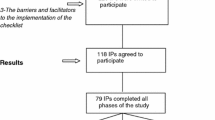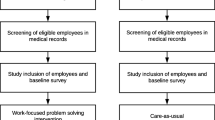Abstract
Purpose
Long-term sick leave (LTSL) is a complex phenomenon. Medical and non-medical factors can delay return-to-work (RTW); therefore, the assessment of work ability is complicated. A checklist for identifying factors associated with delayed RTW was developed in a prior study to facilitate the exploration of barriers and facilitators for RTW. The purpose of the present study was to determine if use of the checklist enhances professional practice of physicians performing work ability assessments of employees on long-term sick leave and whether the reporting of work ability assessments improved when using the checklist in the routinely practice-based context.
Methods
An educational intervention study was performed using qualitative framework analysis. Thirty-five Dutch physicians were asked to identify and report the barriers and facilitators for RTW and the consequences for the work ability and for the prognosis regarding work reintegration using the checklist. A pre-post qualitative analysis of the medical records was performed using a gradual classification of the reporting of the work ability to evaluate the change in reporting following the educational intervention.
Results
A total of 337 work ability assessments were performed using the checklist. The identification of factors influencing RTW and the comprehensiveness of the medical records increased when compared with the reporting before the educational intervention. The reporting of the work ability assessments improved after the educational intervention. Most physicians reported at least one of the factors of the checklist. 72% participants reported and described adequately at least one factor. 48% participants reported how the factors influenced the work ability, 20% participants reported how the factors influenced the prognosis regarding RTW and 12% participants reported which advice was provided by the physician to influence the barriers for RTW.
Conclusions
Use of the checklist enhances professional practice of physicians performing work ability assessments of employees on long-term sick leave and is associated with increased identification of barriers and facilitators for RTW. The use of the checklist should be considered to improve professional practice of physicians performing work ability assessments.
Similar content being viewed by others
References
Alexanderson K, Norlund A (2004) Sickness absence—causes, consequences, and physicians’ sickness certification practice. A systematic literature review by the Swedish Council in Technology Assessment in Health Care. Scand J Public Health 63:3–263
Aspesi AV, Kauffmann GE, Davis AM, Schulwolf EM, Press VG, Stupay KL, Arora VM (2013) IBCD: development and testing of a checklist to improve quality of care for hospitalized general medical patients. Jt Comm J Qual Patient Saf 39(4):147–156
Barratt M (2003) Organizational support for evidence-based practice within child and family social work: a collaborative study. Child Fam Soc Work 8:143–150
Bernacki EJ, Guidera JA, Schaeffer JA, Tsai S (2000) A facilitated early RTW program at a Large Urban Medical Center. J Occup Environ Med 42:1172–1177
Blum F, Burton JF (2006) Workers’ compensation costs in 2005: regional, industrial, and other variations. Work Compens Policy Rev 6:3–20
Bryngelson A (2009) Long-term sickness absence and social exclusion. Scand J Public Health 37(8):839–845
Dekkers-Sánchez PM, Wind H, Sluiter JK, Frings-Dresen MHW (2013) What factors are most relevant to the assessment of work ability of employees on long-term sick leave? The physicians’ perspective. Int Arch Occup Enviro Health 86(5):509–518
Dekkers-Sánchez PM, Wind H, Frings-Dresen MHW, Sluiter JK (2015) Implementation of a checklist to assess factors relevant for work ability assessments of employees on long-term sick leave. Int Arch Occup Environ Health 88:577
Einav Y, Gopher D, Kara I, Ben-Yosef O, Lawn M, Lauffer N et al (2010) Preoperative briefing in the operating room: shared cognition, teamwork, and patient safety. Chest 137:443–449
Floderus B, Goransson S, Alexanderson K, Aronsson G (2005) Self-estimated life situation in patients on long-term sick leave. J Rehabil Med 37(5):291–299
Gawande A (2009) The checklist manifesto: how to get things right. Metropolitan Books, New York
Gibbs LE (2003) Evidence-based practice for the helping professions: a practical guide to integrated multimedia. Brooks/Cole, Pacific Grove
Gibbs LE, Gambrill E (2002) Evidence-based practice: counterarguments to objections. Res Soc Work Pract 12:452–476
Gray Weiskopf N, Weng C (2013) Methods and dimensions of electronic health record data quality assessment: enabling reuse for clinical research. J Am Med Inform Assoc 20(1):144–151
Hagen KB, Thune O (1998) Work incapacity from low back pain in the general population. Spine 23:2091–2095
Hees HL, Nieuwenhuijsen K, Koeter MWJ, Bültmann U, Schene AH (2012) Towards a new definition of return-to-work outcomes in common mental disorders from a multi-stakeholder perspective. PLoS One 7(6):e39947
Henderson M, Glozier N, Elliot KH (2005) Long term sickness absence. BMJ 330:802–803
Hoffmann TC, Glasziou PP, Boutron I, Milne R, Perera R, Moher D, Altman DG, Barbour V, Macdonald H, Johnston M, Lamb SE, Dixon-Woods M, McCulloch P, Wyatt JC, Chan A, Michie S (2014) Better reporting of interventions: template for intervention description and replication (TIDieR) checklist and guide. BMJ 348:g1687
Jetha A, Pransky G, Fish J, Jeffries S, Hettinger LJ (2015) A stakeholder-based system dynamics model of return-to-work: a research protocol. J Public Health Res 4(2):553
Johnston V, Way K, Long MH (2015) Supervisor competencies for supporting return to work: a mixed-methods study. J Occup Rehabil 25:3
Kirk SA, Reid WJ (2002) Science and social work: a critical appraisal. Columbia University Press, New-York
Kostoupoulos G, Rizomyliotis I, Konstantoulaki K (2015) Determinants of physicians ‘purchase intention for innovative services: integrating professional characteristics with technology acceptance model and theory of planned behaviour. Int J Innov Manag 19:02
Lerner D, Amick BC, Lee JC (2003) Relationship of employee-reported work limitations to work productivity. Med Care 41:649–659
Lingard L, Regehr G, Orser B, Reznick R, Baker GR, Doran D, Espin S, Bohnen J, Whyte S (2008) Evaluation of a preoperative checklist and team briefing among surgeons, nurses, and anesthesiologists to reduce failures in communication. Arch Surg 143:12–17
Logan JR, Gorman PN, Middleton B (2001) Measuring the quality of medical records: a method for comparing completeness and correctness of clinical encounter data. Proc AMIA Symp 408–412
McGinlay D, Moore D, Mironescu A (2015) A prospective observational assessment of surgical safety checklist use in Brasov Children’s Hospital, barriers to implementation and methods to improve compliance. Rom J Anaesth Intensive Care 22(2):111–121
McKay MM, Hibbert R, Hoagwood K, Rodriquez L, Murray L, Legerski J, Fernandez D (2004) Integrating evidence-based engagement interventions into “real world” child mental health settings. Brief Treat Crisis Interv 4:177–186
Mullen EJ, Bacon W (2004) A survey of practitioner adoption and implementation of practice guidelines and evidence-based treatments. In: Roberts AR, Yeager K (eds) Evidence-based practice manual: research and outcome measures in health and human services. Oxford University Press, New York
Naylor CD (1995) The grey zones of clinical practice: some limits to evidence-based medicine. Lancet 345(8953):840–842
O’Brien MA, Rogers S, Jamtvedt G, Oxman AD, Odgaard-Jensen J, Kristoffersen DT, Forsetlund L, Bainbridge D, Freemantle N, Davis DA et al (2007) Educational outreach visits: effects on professional practice and health care outcomes. Cochrane Database Syst Rev 17(4):CD000409
OECD (2010) Sickness, disability and work: breaking the Barriers. A Synthesis of findings across OECD countries
OECD (2011) Society at a glance 2011: OECD social indicators. OECD Publishing, Paris
Oxman AD, Thomson MA, Davis DA, Haynes RB (1995) No magic bullets: a systematic review of 102 trials of interventions to improve professional practice. CMAJ Can Med Assoc J 153(10):1423–1431
Papaspyros S, Javangula KC, Adiluri RK, O’Regan DJ (2010) Briefing and debriefing in the cardiac operating room. Analysis of impact on theatre team attitude and patient safety. Interact Cardiovasc Thorac Surg 10:43–47
Phillphysicians AC, Lewis LK, McEvoy MP, Galipeau J, Glasziou P, Moher D, Tilson JK, Williams MT (2016) Development and validation of the guideline for reporting evidence-based practice educational interventions and teaching (GREET). BMC Med Educ 16(1):237
Pope C, Mays N (2006) Qualitative research in health care, 3rd edn. Blackwell publishing Ltd, Hoboken. pp 69–73
Rashidian A, Eccles MP, Russell I (2008) Falling on stony ground? A qualitative study of implementation of clinical guidelines’ prescribing recommendations in primary care. Health policy. 85(2):148–161
Ritchie J, Lewis J (2003) Qualitative research practice: a guide for social science students and researchers. Sage, London
Sieurin L, Josephson M, Vingård E (2009) Positive and negative consequences of sick leave for the individual, with special focus on part-time sick leave. Scand J Public Health 37(1):50–56
Soto C, Kleinman K, Simon S (2002) Quality and correlates of medical record documentation in the ambulatory care setting. BMC Health Serv Res 2:22
Tveito TH, Hysing M, Eriksen HR (2004) Low back pain interventions at the workplace: a systematic literature review. Occup Med 54:3–13
Vingård E, Alexanderson K, Norlund A (2004) Consequences of being on sick leave. Scand J Public Health 32(63suppl):207–215
Virtanen M, Kivimäki M, Vahtera J, Elovainio M, Sund R, Virtanen P, Ferrie JE (2006) Sickness absence as a risk factor for job termination, unemployment, and disability pension among temporary and permanent employees. Occup Environ Med 63(3):212–217
World Health Organization (2001) International classification of functioning, disability and health
Young AE, Wasiak R, Roessler RT, McPherson KM, Anema JR (2005) Return-to-work outcomes following work disability: stakeholder motivations, interests and concerns. J Occup Rehabil 15:543–556
Author information
Authors and Affiliations
Contributions
PMD-S: conception and design, acquisition of data, analysis and interpretation of data, writing the manuscript, revising it critically for important intellectual content, final approval of the version to be published. AW: acquisition of data, qualitative analysis of data, revising it critically for important intellectual content, final approval of the version to be published.
Corresponding author
Ethics declarations
Conflict of interest
The authors declare they have no conflict of interests.
Ethical standards
The present study has been performed in accordance with the ethical standards laid down in the 1964 Declaration of Helsinki and its later amendments.
Additional information
Publisher’s Note
Springer Nature remains neutral with regard to jurisdictional claims in published maps and institutional affiliations.
Rights and permissions
About this article
Cite this article
Dekkers-Sánchez, P.M., de Wind, A.E. Enhancing medical evaluations of sick-listed employees: an educational intervention to improve professional practice of physicians performing work ability assessments of employees on long-term sick leave. Int Arch Occup Environ Health 92, 729–738 (2019). https://doi.org/10.1007/s00420-019-01409-4
Received:
Accepted:
Published:
Issue Date:
DOI: https://doi.org/10.1007/s00420-019-01409-4




